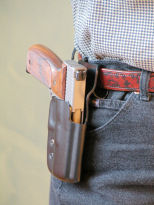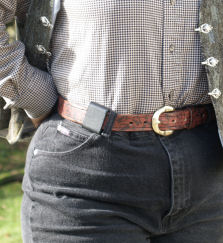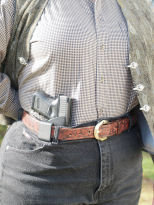When it comes time to pick out a belt holster, the choices seem overwhelming and the terminology mystifying. A holster maker uses words few other people do, and uses familiar words in unusual ways. A rake is something you use in the garden, right? Not to a holster maker! With all the specialized terminology, it isn’t any wonder that the rest of us are often confused.
Here’s a cheat sheet that might help make your next holster-buying expedition a little less confusing.
This glossary includes terms that refer to
- the angle the muzzle will be held,
- how the gun rides on the belt,
- how the gun is attached to the belt,
- the overall shape of the holster,
- where on your belt the holster will be carried,
- and how the holster is made.
For more about finding a holster, please see the following articles:

Terms that refer to the angle the muzzle will be held
 Crossdraw Holster |
Adjustable rake — the angle can easily be changed by the user.
Cant — rake
Extreme rake — the muzzle will be angled more sharply than other designs by the same maker. The exact angle meant by this term varies from one maker to another.
FBI rake — a widely used term, but the specific angle it refers to varies greatly from one holster maker to another.
Muzzle forward — the holstered gun will have its muzzle angled toward the front of your body.
Muzzle rear — the holstered gun will have its muzzle angled toward the rear.
Rake — the angle at which the holster will hold the gun. It is measured by degrees.
Straight drop — the holstered gun will have its muzzle pointed straight toward the floor.

how the gun rides on the belt
 Dropped and offset
|
Drop or dropped — as little of the gun as possible is held above the belt line. This is often more comfortable for people with curvy waistlines, but the tradeoff is that it is not very concealable. However, holsters which combine drop with offset are usually very comfortable and practical for range use.
High ride or high rise — as much of the gun as possible is held above the belt line. This is often more comfortable for people with curvy waistlines, and is very concealable even under short cover garments. The tradeoff is that it can be difficult for short-waisted people, or those with shoulder mobility issues, to easily draw a weapon carried in a high ride holster.
Offset — the whole top portion of the holstered gun is held away from the shooter’s body by a wedge or simply by the shape of the holster. This is usually more comfortable for people with curves and provides better grip accessibility. The tradeoff is that it is bulky, usually isn’t very concealable and often makes the wearer look chunky. However, holsters which combine offset with drop are usually very comfortable and practical for range use.

how the gun is attached to the belt
 Leather OWB
|
Hook or J hook — a piece which partially encircles the belt.
Loop a piece which completely encircles the belt.
Tunnel — the belt is completely enclosed within the holster for some distance.
Slot — an opening in the holster body or wing.
Clip or belt clip — a metal clamp, often covered with leather, which fits over the top half of the belt.

the overall shape of the holster
 Canted OWB pancake
|
Paddle — a wide holster designed to be snapped or clipped onto the belt.
Pancake — a wide holster with slotted wings on either side which increase stability.
Scabbard — designs which fully enclose the muzzle end.
Slide — designs which do not enclose the muzzle end, allowing them to carry otherwise identical guns with different muzzle lengths.

specific features of holster design
Body guard / sweat guard — a high piece on the back of the holster where it touches your body, designed to prevent contact between your body and the exposed part of the holstered gun.
Covered trigger guard — the holster completely covers the entire trigger area, and it is impossible to reach a finger in to touch the trigger of the holstered gun. A completely covered trigger guard is absolutely necessary for safety in a carry rig, because of the potential for clothing or gear to get snagged in it and trigger an unintentional discharge.
Grip accessibility — how easy it is to get a complete grasp on the grip while the gun is in the holster.
Liner, lined — material on the inside of the holster, where the gun rides; occasionally refers to material on the back of the holster, where it touches your body.
 Tuckable kydex holster
|
One-handed reholstering — the holster will stay open when the gun is drawn, enabling you to reholster without holding the mouth of the holster open with your support hand. Absolutely necessary for safety, because otherwise you will point the gun at your support hand every time you holster.
Open top — holsters that don’t have a retention strap.
Retention holster — a holster which has a retention strap or other device intended to prevent the gun from being drawn by anyone but the person wearing it.
Stability — how much the holster wiggles around when you draw or reholster the gun.
Thumb break / retention strap — a strap that goes over the top of the holstered gun and is (usually) snapped in place for security. Called a thumb break because the thumb must break it open in order to draw the weapon. This feature is frequently desirable on holsters which will be carried openly rather than concealed.
Tension — how tightly the gun is held in the holster.
Tension screws — screws which allow the user to adjust how tightly the gun is held in the holster.
Tuckable or shirt tuck feature — enables a shirt to be tucked in over the holstered gun, leaving only the holster’s loop(s) or hooks visible on the belt line.

where on your belt the holster will be carried
 Small of back carry(not recommended |
Appendix carry — the holstered gun is placed forward of the hip on the strong side, usually halfway between belly button and hip bone.
Behind the hip — the holster is placed immediately behind the hip.
Between pants & belt — the holster is placed outside the pants, but inside the belt.
Cross draw — the holstered gun is placed forward of the hip on the support side, usually halfway between belly button and hip bone. It is usually carried butt-forward in this position.
Combination IWB/OWB — the holster can be worn either inside or outside both pants and belt.
IWB (Inside Waist Band) — the holster is placed inside the pants and inside the belt.
On the hip — the holster is placed on the waistline directly below your armpit.
 Canted leather IWB
|
OWB (Outside Waist Band) — the holster is placed outside the pants and outside the belt.
Small of back — the holster is placed in the center of the back, over the spinal cord.
Strong side — the side corresponding to the dominant hand. The holstered gun is usually placed butt-rearward when worn on the strong side.
Weak or support side — the side corresponding to the non-dominant hand.

and how the holster is made.
 Kydex holster,
|
Combination kydex / leather — a holster which includes both kydex and leather in its design.
Custom holster — a holster that is made just for you to your specifications. Often surprisingly affordable, but also often involves a lengthy wait.
Injection-molded — a process used to form kydex or plastic holsters inside a hollow mold by injecting completely melted polymer into the mold. Non-injection-molded holsters are made by placing sheets of skydex or plastic over a form and partially melting them until they conform to the proper shape.
Kydex — a very sturdy polymer which has characteristics that make it work well for holsters.
Leather — gunleather is usually made of cowhide or horsehide, but may be trimmed with exotic leathers such as shark or snakeskin.
Plastic — a polymer which is less expensive and generally less sturdy than kydex.



